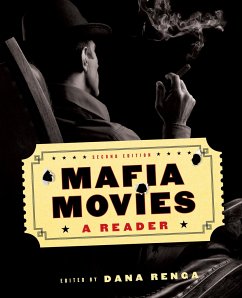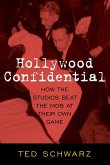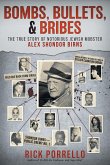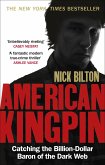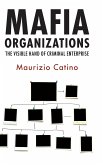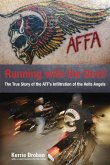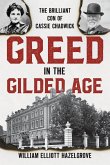Mafia Movies
A Reader, Second Edition
Herausgeber: Renga, Dana
Mafia Movies
A Reader, Second Edition
Herausgeber: Renga, Dana
- Gebundenes Buch
- Merkliste
- Auf die Merkliste
- Bewerten Bewerten
- Teilen
- Produkt teilen
- Produkterinnerung
- Produkterinnerung
The mafia has always fascinated filmmakers and television producers. Al Capone, Salvatore Giuliano, Lucky Luciano, Ciro Di Marzio, Roberto Saviano, Don Vito and Michael Corleone, and Tony Soprano are some of the historical and fictional figures that contribute to the myth of the Italian and Italian-American mafias perpetuated onscreen. This collection looks at mafia movies and television over time and across cultures, from the early classics to the Godfather trilogy and contemporary Italian films and television series. The only comprehensive collection of its type, Mafia Movies treats over…mehr
Andere Kunden interessierten sich auch für
![Hollywood Confidential Hollywood Confidential]() Ted SchwarzHollywood Confidential20,99 €
Ted SchwarzHollywood Confidential20,99 €![From The Mob To The Movies From The Mob To The Movies]() Richie SalernoFrom The Mob To The Movies16,99 €
Richie SalernoFrom The Mob To The Movies16,99 €![Bombs, Bullets, and Bribes Bombs, Bullets, and Bribes]() Rick PorrelloBombs, Bullets, and Bribes16,99 €
Rick PorrelloBombs, Bullets, and Bribes16,99 €![American Kingpin American Kingpin]() Nick BiltonAmerican Kingpin12,99 €
Nick BiltonAmerican Kingpin12,99 €![Mafia Organizations Mafia Organizations]() Maurizio CatinoMafia Organizations79,99 €
Maurizio CatinoMafia Organizations79,99 €![Running with the Devil Running with the Devil]() Kerrie DrobanRunning with the Devil15,99 €
Kerrie DrobanRunning with the Devil15,99 €![Greed in the Gilded Age Greed in the Gilded Age]() William Elliott HazelgroveGreed in the Gilded Age17,99 €
William Elliott HazelgroveGreed in the Gilded Age17,99 €-
-
-
The mafia has always fascinated filmmakers and television producers. Al Capone, Salvatore Giuliano, Lucky Luciano, Ciro Di Marzio, Roberto Saviano, Don Vito and Michael Corleone, and Tony Soprano are some of the historical and fictional figures that contribute to the myth of the Italian and Italian-American mafias perpetuated onscreen. This collection looks at mafia movies and television over time and across cultures, from the early classics to the Godfather trilogy and contemporary Italian films and television series. The only comprehensive collection of its type, Mafia Movies treats over fifty films and TV shows created since 1906, while introducing Italian and Italian-American mafia history and culture. The second edition includes new original essays on essential films and TV shows that have emerged since the publication of the first edition, such as Boardwalk Empire and Mob Wives, as well as a new roundtable section on Italy’s “other” mafias in film and television, written as a collaborative essay by more than ten scholars. The edition also introduces a new section called “Double Takes” that elaborates on some of the most popular mafia films and TV shows (e.g. The Godfather and The Sopranos) organized around themes such as adaptation, gender and politics, urban spaces, and performance and stardom.
Hinweis: Dieser Artikel kann nur an eine deutsche Lieferadresse ausgeliefert werden.
Hinweis: Dieser Artikel kann nur an eine deutsche Lieferadresse ausgeliefert werden.
Produktdetails
- Produktdetails
- Verlag: University of Toronto Press
- 2nd edition
- Seitenzahl: 464
- Erscheinungstermin: 5. Juli 2019
- Englisch
- Abmessung: 236mm x 193mm x 33mm
- Gewicht: 1043g
- ISBN-13: 9781487500238
- ISBN-10: 1487500238
- Artikelnr.: 55901407
- Herstellerkennzeichnung
- Libri GmbH
- Europaallee 1
- 36244 Bad Hersfeld
- gpsr@libri.de
- Verlag: University of Toronto Press
- 2nd edition
- Seitenzahl: 464
- Erscheinungstermin: 5. Juli 2019
- Englisch
- Abmessung: 236mm x 193mm x 33mm
- Gewicht: 1043g
- ISBN-13: 9781487500238
- ISBN-10: 1487500238
- Artikelnr.: 55901407
- Herstellerkennzeichnung
- Libri GmbH
- Europaallee 1
- 36244 Bad Hersfeld
- gpsr@libri.de
Edited by Dana Renga
Acknowledgments
Part One. Setting the Scene
1. The Corleones at Home and Abroad
Dana Renga, Ohio State University
2. Gender and Violence: Four Themes in the Everyday World of Mafia Wives
Jane Schneider, Graduate Center, CUNY (Emeritus) and Peter Schneider,
Fordham University(Emeritus)
Part Two. American Mafia Movies and Television: The Corleones at Home and
Abroad
3. Wallace McCutcheon’s The Black Hand: A Different Version of a Biograph
Kidnapping
Vincenzo Maggitti, University of Stockholm
4 ‘Most Thrilling Subjects’: D.W. Griffith and the Biograph Revenge Films
JoAnne Ruvoli, Ball State University
5. Ethnicity and the Classical Gangster Film: Mervyn LeRoy’s Little Caesar
and Howard Hawks’s Scarface
Norma Bouchard, San Diego State University
6. Playing Good Italian/Bad Italian on ABC’s The Untouchables
Jonathan J. Cavallero, Bates College
7 Prelude to The Godfather: Martin Ritt’s The Brotherhood
Robert Casillo, University of Miami
8. Michael Corleone’s Tie: Francis Ford Coppola’s The Godfather
Anthony Julian Tamburri, John D. Calandra Italian American Institute,
Queens College/CUNY
9. Nihilism and Mafiosita in Martin Scorsese’s Mean Streets
Pellegrino D’Acierno, Hofstra University
10. Thematic Patterns in Francis Ford Coppola’s The Godfather: Part II
John Paul Russo, University of Miami
11. The Sexual Politics of Loyalty in John Huston’s Prizzi’s Honor
Rebecca Bauman, Fashion Institute of Technology
12. Between Postmodern Parody and Generic Hybridization: The Gangsters of
Brian De Palma’s The Untouchables
Norma Bouchard, San Diego State University
13. The Bandit, the Gangster, and the American Army Shorts: Michael
Cimino’s The Sicilian
Chiara Mazzucchelli, The University of Central Florida
14. Martin Scorsese’s Goodfellas: Hybrid Storytelling between Realism and
Formalism
Fulvio Orsitto, California State University
15. Redemption in Francis Ford Coppola’s The Godfather: Part III
John Paul Russo, University of Miami
16. Narrating the Mafia, Las Vegas, and Ethnicity in Martin Scorsese’s
Casino
Claudio Bisoni, University of Bologna
17. ‘Nothing Romantic about It’: Gender and the Legacy of Crime in Abel
Ferrara’s The Funeral
Lara Santoro, Drew University
18. Inside the Mafia: Mike Newell’s Donnie Brasco
Robert Casillo, University of Miami
19. Family Therapy: Harold Ramis’s Analyze This and the Evolution of the
Gangster Genre
Louis Bayman, University of Southampton
20. Martin Scorsese’s The Departed, or the Quest for a Departed (Ethnic)
Identity
Margherita Heyer-Caput, University of California
21. When Words Can Kill: David Chase’s The Sopranos
Franco Ricci, The University of Ottawa
22. ‘Don’t Stop Believin’, Don’t Stop ...’: (De)Structuring Expectations in
the Final Season of The Sopranos
Giancarlo Lombardi, College of Staten Island & CUNY Graduate Center
23. ‘History Doesn’t Repeat Itself, but It Does Rhyme’: Fictionalizing
History in Boardwalk Empire
Paolo Russo, Oxford Brookes University
24. Mob Wives: Exploitation or Empowerment?
Jacqueline Reich, Fordham University and Fatima Karin, Fordham University
Part Three. Italian Mafia Movies and Television: Resistance and Myth
25. Which Law Is the Father’s? Gender and Generic Oscillation in Pietro
Germi’s In the Name of the Law
Danielle Hipkins, University of Exeter, University of Exeter
26. The Visible, Unexposed: Francesco Rosi’s Salvatore Giuliano
Laura Wittman, Stanford University
27. Modernity, Mafia Style: Alberto Lattuada’s Mafioso
Nelson Moe, Barnard College, Columbia University
28. Francesco Rosi’s Hands over the City: A Contemporary Perspective on the
Camorra
Anna Paparcone, Bucknell University
29. Prototypes of the Mafia: Luchino Visconti’s The Leopard
Elizabeth Leake, Columbia University
30. The Failure of the Intellectual: Elio Petri’s Filming of Leonardo
Sciascia’s To Each His Own
Daniela Bini, University of Texas
31. Damiano Damiani’s The Day of the Owl: A Western Flirtation
Piero Garofalo, University of New Hampshire
32. Smaller and Larger Families: Lina Wertmüller’s The Seduction of Mimi
Thomas Harrison, University of California, Los Angeles
33. Deconstructing the Enigma: Logical Investigations in Francesco Rosi’s
Lucky Luciano
Gaetana Marrone, Princeton University
34. Power as Such: The Idea of the Mafia in Francesco Rosi’s Illustrious
Corpses
Alan O’Leary, University of Leeds
35. Marco Risi’s Forever Mary: Desperate Lives Converge in Sicilia ‘Non
Bedda’
George De Stefano, Author and Critic
36. Threads of Political Violence in Italy’s Spiderweb: Giorgio Ambrosoli’s
Murder in Michele Placido’s A Bourgeois Hero
Carlo Testa, University of British Columbia
37. Sacrifice, Sacrament, and the Body in Ricky Tognazzi’s La scorta
Myriam Swennen Ruthenberg, Florida Atlantic University
38. Pasquale Scimeca’s Placido Rizzotto: A Different View of Corleone
Amy Boylan, The University of New Hampshire
39. Marco Tullio Giordana’s The Hundred Steps: The Biopic as Political
Cinema
George De Stefano, Author and Critic
40. Roberta Torre’s Angela: The Mafia and the ‘Woman’s Film’
Catherine O’Rawe, University of Bristol
41. Organized Crime and Unfulfilled Promises in Gabriele Salvatores’ I’m
Not Scared
Michael O’Riley, Colorado College
42. Growing Up Camorrista: Antonio and Andrea Frazzi’s Certi bambini
Allison Cooper, Bowdoin College
43. Lipstick and Chocolate: Paolo Sorrentino’s The Consequences of Love
Mary P Wood, Birkbeck, University of London
44. The In(di)visibility of the Mafia, Politics, and Ethics in Bianchi and
Nerazzini’s The Mafia Is White
Robin Pickering-Iazzi, The University of Wisconsin
45. Marco Turco’s Excellent Cadavers: An Italian Tragedy
Maddalena Spazzini, Richmond College
46. Dispatches from Hell: Matteo Garrone’s Gomorrah
Pierpaolo Antonello, The University of Cambridge
47. From Comedy to Commemoration: Pierfrancesco Diliberto’s La mafia uccide
solo d’estate
Millicent Marcus, Yale University
48. Fabio Grassadonia and Antonio Piazza’s Salvo: The Sound of Redemption
in an Infernal Landscape
Amy Boylan, The University of New Hampshire
49. Of Renegades and Game Players: Shifting Sympathies in Gomorra: la serie
Giancarlo Lombardi, College of Staten Island & CUNY Graduate Center
Part Four. Italy’s Other Mafias in Film and on Television: A Roundtable
50. Introduction - The Banda della Magliana, the Camorra, the ’Ndrangheta,
and the Sacra Corona Unita: The Mafia On Screen beyond the Cosa Nostra
Dana Renga, Ohio State University
51. Historicizing Italy’s Other Mafias: Some Considerations
John Dickie, University College London
52. Romanzo criminale: Roma Caput Violandi
Allison Cooper, Bowdoin College
53. Romanzo criminale: la serie
Catherine O’Rawe, University of Bristol
54. Toxic Tables: The Representation of Food in Camorra Films
Amy Boylan, The University of New Hampshire
55. The New Mafia in Una vita tranquilla
Giovanna De Luca, College of Charleston
56. Soap Operas
Giancarlo Lombardi, College of Staten Island & CUNY Graduate Center
57. Response #1
Robert Gordon, The University of Cambridge
58. Response #2
Danielle Hipkins, University of Exeter
59. Response #3
Robin Pickering-Iazzi, The University of Wisconsin
60. Conclusion
Allison Cooper, Bowdoin College
Part Five. Double Takes
The Godfather
61. The Godfather: Performance and Stardom
Dominic Holdaway, Università Cattolica del Sacro Cuor
62. The Godfather: Adaptation
Alberto Zambenedetti, University of Toronto
63. The Godfather: Gender
Dana Renga, Ohio State University
64. The Godfather: Scene Analysis - Don Vito’s Office
Alberto Zambenedetti, University of Toronto
65. The Godfather: Scene Analysis - The Baptism/Murder
Alberto Zambenedetti, University of Toronto
66. The Godfather: Scene Analysis - The Finale
Daniel Paul, The Ohio State University
The Sopranos
67. The Sopranos: Antiheroic Masculinity
Dana Renga, Ohio State University
68. The Sopranos: Gender
Dominic Holdaway, Università Cattolica del Sacro Cuor
69. The Sopranos: (Sub)Urban Space
Alberto Zambenedetti, University of Toronto
70. The Sopranos: Episode 1.01, ‘The Sopranos’
Dominic Holdaway, Università Cattolica del Sacro Cuor
71 The Sopranos: Episode 1.05, ‘College’
Sean O’Sullivan, The Ohio State University
72. The Sopranos: Episode 2.04, ‘Commendatori’
Sean O’Sullivan, The Ohio State University
Romanzo criminale
73. Romanzo criminale: Performance and Stardom
Catherine O’Rawe, University of Bristol
74. Romanzo criminale: Adaptation/Transmedia
Dominic Holdaway, Università Cattolica del Sacro Cuor
75. Romanzo criminale: Gender
Danielle Hipkins, University of Exeter
76. Romanzo criminale: Politics and Terrorism
Dominic Holdaway, Università Cattolica del Sacro Cuor
77. Romanzo criminale: Scene Analysis - The Aldo Moro Kidnapping
Catherine O’Rawe, University of Bristol
78. Romanzo criminale: Scene Analysis - The Bologna Bombing
Alan O’Leary, University of Leeds
Gomorrah
79. Gomorrah: Gender
Elena Past, Wayne State University
80. Gomorrah: Metacinematic References
Alberto Zambenedetti, University of Toronto
81. Gomorrah: Urban Space
Monica Seger, William and Mary University
82. Gomorrah: Scene Analysis - Opening Sequence
Alberto Zambenedetti, University of Toronto
83. Gomorrah: Scene Analysis - The Initiation of Totò
Alberto Zambenedetti, University of Toronto
84. Gomorrah: Scene Analysis - The Finale
Monica Seger, William and Mary University
Filmography
Selected Bibliography
Contributors
Part One. Setting the Scene
1. The Corleones at Home and Abroad
Dana Renga, Ohio State University
2. Gender and Violence: Four Themes in the Everyday World of Mafia Wives
Jane Schneider, Graduate Center, CUNY (Emeritus) and Peter Schneider,
Fordham University(Emeritus)
Part Two. American Mafia Movies and Television: The Corleones at Home and
Abroad
3. Wallace McCutcheon’s The Black Hand: A Different Version of a Biograph
Kidnapping
Vincenzo Maggitti, University of Stockholm
4 ‘Most Thrilling Subjects’: D.W. Griffith and the Biograph Revenge Films
JoAnne Ruvoli, Ball State University
5. Ethnicity and the Classical Gangster Film: Mervyn LeRoy’s Little Caesar
and Howard Hawks’s Scarface
Norma Bouchard, San Diego State University
6. Playing Good Italian/Bad Italian on ABC’s The Untouchables
Jonathan J. Cavallero, Bates College
7 Prelude to The Godfather: Martin Ritt’s The Brotherhood
Robert Casillo, University of Miami
8. Michael Corleone’s Tie: Francis Ford Coppola’s The Godfather
Anthony Julian Tamburri, John D. Calandra Italian American Institute,
Queens College/CUNY
9. Nihilism and Mafiosita in Martin Scorsese’s Mean Streets
Pellegrino D’Acierno, Hofstra University
10. Thematic Patterns in Francis Ford Coppola’s The Godfather: Part II
John Paul Russo, University of Miami
11. The Sexual Politics of Loyalty in John Huston’s Prizzi’s Honor
Rebecca Bauman, Fashion Institute of Technology
12. Between Postmodern Parody and Generic Hybridization: The Gangsters of
Brian De Palma’s The Untouchables
Norma Bouchard, San Diego State University
13. The Bandit, the Gangster, and the American Army Shorts: Michael
Cimino’s The Sicilian
Chiara Mazzucchelli, The University of Central Florida
14. Martin Scorsese’s Goodfellas: Hybrid Storytelling between Realism and
Formalism
Fulvio Orsitto, California State University
15. Redemption in Francis Ford Coppola’s The Godfather: Part III
John Paul Russo, University of Miami
16. Narrating the Mafia, Las Vegas, and Ethnicity in Martin Scorsese’s
Casino
Claudio Bisoni, University of Bologna
17. ‘Nothing Romantic about It’: Gender and the Legacy of Crime in Abel
Ferrara’s The Funeral
Lara Santoro, Drew University
18. Inside the Mafia: Mike Newell’s Donnie Brasco
Robert Casillo, University of Miami
19. Family Therapy: Harold Ramis’s Analyze This and the Evolution of the
Gangster Genre
Louis Bayman, University of Southampton
20. Martin Scorsese’s The Departed, or the Quest for a Departed (Ethnic)
Identity
Margherita Heyer-Caput, University of California
21. When Words Can Kill: David Chase’s The Sopranos
Franco Ricci, The University of Ottawa
22. ‘Don’t Stop Believin’, Don’t Stop ...’: (De)Structuring Expectations in
the Final Season of The Sopranos
Giancarlo Lombardi, College of Staten Island & CUNY Graduate Center
23. ‘History Doesn’t Repeat Itself, but It Does Rhyme’: Fictionalizing
History in Boardwalk Empire
Paolo Russo, Oxford Brookes University
24. Mob Wives: Exploitation or Empowerment?
Jacqueline Reich, Fordham University and Fatima Karin, Fordham University
Part Three. Italian Mafia Movies and Television: Resistance and Myth
25. Which Law Is the Father’s? Gender and Generic Oscillation in Pietro
Germi’s In the Name of the Law
Danielle Hipkins, University of Exeter, University of Exeter
26. The Visible, Unexposed: Francesco Rosi’s Salvatore Giuliano
Laura Wittman, Stanford University
27. Modernity, Mafia Style: Alberto Lattuada’s Mafioso
Nelson Moe, Barnard College, Columbia University
28. Francesco Rosi’s Hands over the City: A Contemporary Perspective on the
Camorra
Anna Paparcone, Bucknell University
29. Prototypes of the Mafia: Luchino Visconti’s The Leopard
Elizabeth Leake, Columbia University
30. The Failure of the Intellectual: Elio Petri’s Filming of Leonardo
Sciascia’s To Each His Own
Daniela Bini, University of Texas
31. Damiano Damiani’s The Day of the Owl: A Western Flirtation
Piero Garofalo, University of New Hampshire
32. Smaller and Larger Families: Lina Wertmüller’s The Seduction of Mimi
Thomas Harrison, University of California, Los Angeles
33. Deconstructing the Enigma: Logical Investigations in Francesco Rosi’s
Lucky Luciano
Gaetana Marrone, Princeton University
34. Power as Such: The Idea of the Mafia in Francesco Rosi’s Illustrious
Corpses
Alan O’Leary, University of Leeds
35. Marco Risi’s Forever Mary: Desperate Lives Converge in Sicilia ‘Non
Bedda’
George De Stefano, Author and Critic
36. Threads of Political Violence in Italy’s Spiderweb: Giorgio Ambrosoli’s
Murder in Michele Placido’s A Bourgeois Hero
Carlo Testa, University of British Columbia
37. Sacrifice, Sacrament, and the Body in Ricky Tognazzi’s La scorta
Myriam Swennen Ruthenberg, Florida Atlantic University
38. Pasquale Scimeca’s Placido Rizzotto: A Different View of Corleone
Amy Boylan, The University of New Hampshire
39. Marco Tullio Giordana’s The Hundred Steps: The Biopic as Political
Cinema
George De Stefano, Author and Critic
40. Roberta Torre’s Angela: The Mafia and the ‘Woman’s Film’
Catherine O’Rawe, University of Bristol
41. Organized Crime and Unfulfilled Promises in Gabriele Salvatores’ I’m
Not Scared
Michael O’Riley, Colorado College
42. Growing Up Camorrista: Antonio and Andrea Frazzi’s Certi bambini
Allison Cooper, Bowdoin College
43. Lipstick and Chocolate: Paolo Sorrentino’s The Consequences of Love
Mary P Wood, Birkbeck, University of London
44. The In(di)visibility of the Mafia, Politics, and Ethics in Bianchi and
Nerazzini’s The Mafia Is White
Robin Pickering-Iazzi, The University of Wisconsin
45. Marco Turco’s Excellent Cadavers: An Italian Tragedy
Maddalena Spazzini, Richmond College
46. Dispatches from Hell: Matteo Garrone’s Gomorrah
Pierpaolo Antonello, The University of Cambridge
47. From Comedy to Commemoration: Pierfrancesco Diliberto’s La mafia uccide
solo d’estate
Millicent Marcus, Yale University
48. Fabio Grassadonia and Antonio Piazza’s Salvo: The Sound of Redemption
in an Infernal Landscape
Amy Boylan, The University of New Hampshire
49. Of Renegades and Game Players: Shifting Sympathies in Gomorra: la serie
Giancarlo Lombardi, College of Staten Island & CUNY Graduate Center
Part Four. Italy’s Other Mafias in Film and on Television: A Roundtable
50. Introduction - The Banda della Magliana, the Camorra, the ’Ndrangheta,
and the Sacra Corona Unita: The Mafia On Screen beyond the Cosa Nostra
Dana Renga, Ohio State University
51. Historicizing Italy’s Other Mafias: Some Considerations
John Dickie, University College London
52. Romanzo criminale: Roma Caput Violandi
Allison Cooper, Bowdoin College
53. Romanzo criminale: la serie
Catherine O’Rawe, University of Bristol
54. Toxic Tables: The Representation of Food in Camorra Films
Amy Boylan, The University of New Hampshire
55. The New Mafia in Una vita tranquilla
Giovanna De Luca, College of Charleston
56. Soap Operas
Giancarlo Lombardi, College of Staten Island & CUNY Graduate Center
57. Response #1
Robert Gordon, The University of Cambridge
58. Response #2
Danielle Hipkins, University of Exeter
59. Response #3
Robin Pickering-Iazzi, The University of Wisconsin
60. Conclusion
Allison Cooper, Bowdoin College
Part Five. Double Takes
The Godfather
61. The Godfather: Performance and Stardom
Dominic Holdaway, Università Cattolica del Sacro Cuor
62. The Godfather: Adaptation
Alberto Zambenedetti, University of Toronto
63. The Godfather: Gender
Dana Renga, Ohio State University
64. The Godfather: Scene Analysis - Don Vito’s Office
Alberto Zambenedetti, University of Toronto
65. The Godfather: Scene Analysis - The Baptism/Murder
Alberto Zambenedetti, University of Toronto
66. The Godfather: Scene Analysis - The Finale
Daniel Paul, The Ohio State University
The Sopranos
67. The Sopranos: Antiheroic Masculinity
Dana Renga, Ohio State University
68. The Sopranos: Gender
Dominic Holdaway, Università Cattolica del Sacro Cuor
69. The Sopranos: (Sub)Urban Space
Alberto Zambenedetti, University of Toronto
70. The Sopranos: Episode 1.01, ‘The Sopranos’
Dominic Holdaway, Università Cattolica del Sacro Cuor
71 The Sopranos: Episode 1.05, ‘College’
Sean O’Sullivan, The Ohio State University
72. The Sopranos: Episode 2.04, ‘Commendatori’
Sean O’Sullivan, The Ohio State University
Romanzo criminale
73. Romanzo criminale: Performance and Stardom
Catherine O’Rawe, University of Bristol
74. Romanzo criminale: Adaptation/Transmedia
Dominic Holdaway, Università Cattolica del Sacro Cuor
75. Romanzo criminale: Gender
Danielle Hipkins, University of Exeter
76. Romanzo criminale: Politics and Terrorism
Dominic Holdaway, Università Cattolica del Sacro Cuor
77. Romanzo criminale: Scene Analysis - The Aldo Moro Kidnapping
Catherine O’Rawe, University of Bristol
78. Romanzo criminale: Scene Analysis - The Bologna Bombing
Alan O’Leary, University of Leeds
Gomorrah
79. Gomorrah: Gender
Elena Past, Wayne State University
80. Gomorrah: Metacinematic References
Alberto Zambenedetti, University of Toronto
81. Gomorrah: Urban Space
Monica Seger, William and Mary University
82. Gomorrah: Scene Analysis - Opening Sequence
Alberto Zambenedetti, University of Toronto
83. Gomorrah: Scene Analysis - The Initiation of Totò
Alberto Zambenedetti, University of Toronto
84. Gomorrah: Scene Analysis - The Finale
Monica Seger, William and Mary University
Filmography
Selected Bibliography
Contributors
Acknowledgments
Part One. Setting the Scene
1. The Corleones at Home and Abroad
Dana Renga, Ohio State University
2. Gender and Violence: Four Themes in the Everyday World of Mafia Wives
Jane Schneider, Graduate Center, CUNY (Emeritus) and Peter Schneider,
Fordham University(Emeritus)
Part Two. American Mafia Movies and Television: The Corleones at Home and
Abroad
3. Wallace McCutcheon’s The Black Hand: A Different Version of a Biograph
Kidnapping
Vincenzo Maggitti, University of Stockholm
4 ‘Most Thrilling Subjects’: D.W. Griffith and the Biograph Revenge Films
JoAnne Ruvoli, Ball State University
5. Ethnicity and the Classical Gangster Film: Mervyn LeRoy’s Little Caesar
and Howard Hawks’s Scarface
Norma Bouchard, San Diego State University
6. Playing Good Italian/Bad Italian on ABC’s The Untouchables
Jonathan J. Cavallero, Bates College
7 Prelude to The Godfather: Martin Ritt’s The Brotherhood
Robert Casillo, University of Miami
8. Michael Corleone’s Tie: Francis Ford Coppola’s The Godfather
Anthony Julian Tamburri, John D. Calandra Italian American Institute,
Queens College/CUNY
9. Nihilism and Mafiosita in Martin Scorsese’s Mean Streets
Pellegrino D’Acierno, Hofstra University
10. Thematic Patterns in Francis Ford Coppola’s The Godfather: Part II
John Paul Russo, University of Miami
11. The Sexual Politics of Loyalty in John Huston’s Prizzi’s Honor
Rebecca Bauman, Fashion Institute of Technology
12. Between Postmodern Parody and Generic Hybridization: The Gangsters of
Brian De Palma’s The Untouchables
Norma Bouchard, San Diego State University
13. The Bandit, the Gangster, and the American Army Shorts: Michael
Cimino’s The Sicilian
Chiara Mazzucchelli, The University of Central Florida
14. Martin Scorsese’s Goodfellas: Hybrid Storytelling between Realism and
Formalism
Fulvio Orsitto, California State University
15. Redemption in Francis Ford Coppola’s The Godfather: Part III
John Paul Russo, University of Miami
16. Narrating the Mafia, Las Vegas, and Ethnicity in Martin Scorsese’s
Casino
Claudio Bisoni, University of Bologna
17. ‘Nothing Romantic about It’: Gender and the Legacy of Crime in Abel
Ferrara’s The Funeral
Lara Santoro, Drew University
18. Inside the Mafia: Mike Newell’s Donnie Brasco
Robert Casillo, University of Miami
19. Family Therapy: Harold Ramis’s Analyze This and the Evolution of the
Gangster Genre
Louis Bayman, University of Southampton
20. Martin Scorsese’s The Departed, or the Quest for a Departed (Ethnic)
Identity
Margherita Heyer-Caput, University of California
21. When Words Can Kill: David Chase’s The Sopranos
Franco Ricci, The University of Ottawa
22. ‘Don’t Stop Believin’, Don’t Stop ...’: (De)Structuring Expectations in
the Final Season of The Sopranos
Giancarlo Lombardi, College of Staten Island & CUNY Graduate Center
23. ‘History Doesn’t Repeat Itself, but It Does Rhyme’: Fictionalizing
History in Boardwalk Empire
Paolo Russo, Oxford Brookes University
24. Mob Wives: Exploitation or Empowerment?
Jacqueline Reich, Fordham University and Fatima Karin, Fordham University
Part Three. Italian Mafia Movies and Television: Resistance and Myth
25. Which Law Is the Father’s? Gender and Generic Oscillation in Pietro
Germi’s In the Name of the Law
Danielle Hipkins, University of Exeter, University of Exeter
26. The Visible, Unexposed: Francesco Rosi’s Salvatore Giuliano
Laura Wittman, Stanford University
27. Modernity, Mafia Style: Alberto Lattuada’s Mafioso
Nelson Moe, Barnard College, Columbia University
28. Francesco Rosi’s Hands over the City: A Contemporary Perspective on the
Camorra
Anna Paparcone, Bucknell University
29. Prototypes of the Mafia: Luchino Visconti’s The Leopard
Elizabeth Leake, Columbia University
30. The Failure of the Intellectual: Elio Petri’s Filming of Leonardo
Sciascia’s To Each His Own
Daniela Bini, University of Texas
31. Damiano Damiani’s The Day of the Owl: A Western Flirtation
Piero Garofalo, University of New Hampshire
32. Smaller and Larger Families: Lina Wertmüller’s The Seduction of Mimi
Thomas Harrison, University of California, Los Angeles
33. Deconstructing the Enigma: Logical Investigations in Francesco Rosi’s
Lucky Luciano
Gaetana Marrone, Princeton University
34. Power as Such: The Idea of the Mafia in Francesco Rosi’s Illustrious
Corpses
Alan O’Leary, University of Leeds
35. Marco Risi’s Forever Mary: Desperate Lives Converge in Sicilia ‘Non
Bedda’
George De Stefano, Author and Critic
36. Threads of Political Violence in Italy’s Spiderweb: Giorgio Ambrosoli’s
Murder in Michele Placido’s A Bourgeois Hero
Carlo Testa, University of British Columbia
37. Sacrifice, Sacrament, and the Body in Ricky Tognazzi’s La scorta
Myriam Swennen Ruthenberg, Florida Atlantic University
38. Pasquale Scimeca’s Placido Rizzotto: A Different View of Corleone
Amy Boylan, The University of New Hampshire
39. Marco Tullio Giordana’s The Hundred Steps: The Biopic as Political
Cinema
George De Stefano, Author and Critic
40. Roberta Torre’s Angela: The Mafia and the ‘Woman’s Film’
Catherine O’Rawe, University of Bristol
41. Organized Crime and Unfulfilled Promises in Gabriele Salvatores’ I’m
Not Scared
Michael O’Riley, Colorado College
42. Growing Up Camorrista: Antonio and Andrea Frazzi’s Certi bambini
Allison Cooper, Bowdoin College
43. Lipstick and Chocolate: Paolo Sorrentino’s The Consequences of Love
Mary P Wood, Birkbeck, University of London
44. The In(di)visibility of the Mafia, Politics, and Ethics in Bianchi and
Nerazzini’s The Mafia Is White
Robin Pickering-Iazzi, The University of Wisconsin
45. Marco Turco’s Excellent Cadavers: An Italian Tragedy
Maddalena Spazzini, Richmond College
46. Dispatches from Hell: Matteo Garrone’s Gomorrah
Pierpaolo Antonello, The University of Cambridge
47. From Comedy to Commemoration: Pierfrancesco Diliberto’s La mafia uccide
solo d’estate
Millicent Marcus, Yale University
48. Fabio Grassadonia and Antonio Piazza’s Salvo: The Sound of Redemption
in an Infernal Landscape
Amy Boylan, The University of New Hampshire
49. Of Renegades and Game Players: Shifting Sympathies in Gomorra: la serie
Giancarlo Lombardi, College of Staten Island & CUNY Graduate Center
Part Four. Italy’s Other Mafias in Film and on Television: A Roundtable
50. Introduction - The Banda della Magliana, the Camorra, the ’Ndrangheta,
and the Sacra Corona Unita: The Mafia On Screen beyond the Cosa Nostra
Dana Renga, Ohio State University
51. Historicizing Italy’s Other Mafias: Some Considerations
John Dickie, University College London
52. Romanzo criminale: Roma Caput Violandi
Allison Cooper, Bowdoin College
53. Romanzo criminale: la serie
Catherine O’Rawe, University of Bristol
54. Toxic Tables: The Representation of Food in Camorra Films
Amy Boylan, The University of New Hampshire
55. The New Mafia in Una vita tranquilla
Giovanna De Luca, College of Charleston
56. Soap Operas
Giancarlo Lombardi, College of Staten Island & CUNY Graduate Center
57. Response #1
Robert Gordon, The University of Cambridge
58. Response #2
Danielle Hipkins, University of Exeter
59. Response #3
Robin Pickering-Iazzi, The University of Wisconsin
60. Conclusion
Allison Cooper, Bowdoin College
Part Five. Double Takes
The Godfather
61. The Godfather: Performance and Stardom
Dominic Holdaway, Università Cattolica del Sacro Cuor
62. The Godfather: Adaptation
Alberto Zambenedetti, University of Toronto
63. The Godfather: Gender
Dana Renga, Ohio State University
64. The Godfather: Scene Analysis - Don Vito’s Office
Alberto Zambenedetti, University of Toronto
65. The Godfather: Scene Analysis - The Baptism/Murder
Alberto Zambenedetti, University of Toronto
66. The Godfather: Scene Analysis - The Finale
Daniel Paul, The Ohio State University
The Sopranos
67. The Sopranos: Antiheroic Masculinity
Dana Renga, Ohio State University
68. The Sopranos: Gender
Dominic Holdaway, Università Cattolica del Sacro Cuor
69. The Sopranos: (Sub)Urban Space
Alberto Zambenedetti, University of Toronto
70. The Sopranos: Episode 1.01, ‘The Sopranos’
Dominic Holdaway, Università Cattolica del Sacro Cuor
71 The Sopranos: Episode 1.05, ‘College’
Sean O’Sullivan, The Ohio State University
72. The Sopranos: Episode 2.04, ‘Commendatori’
Sean O’Sullivan, The Ohio State University
Romanzo criminale
73. Romanzo criminale: Performance and Stardom
Catherine O’Rawe, University of Bristol
74. Romanzo criminale: Adaptation/Transmedia
Dominic Holdaway, Università Cattolica del Sacro Cuor
75. Romanzo criminale: Gender
Danielle Hipkins, University of Exeter
76. Romanzo criminale: Politics and Terrorism
Dominic Holdaway, Università Cattolica del Sacro Cuor
77. Romanzo criminale: Scene Analysis - The Aldo Moro Kidnapping
Catherine O’Rawe, University of Bristol
78. Romanzo criminale: Scene Analysis - The Bologna Bombing
Alan O’Leary, University of Leeds
Gomorrah
79. Gomorrah: Gender
Elena Past, Wayne State University
80. Gomorrah: Metacinematic References
Alberto Zambenedetti, University of Toronto
81. Gomorrah: Urban Space
Monica Seger, William and Mary University
82. Gomorrah: Scene Analysis - Opening Sequence
Alberto Zambenedetti, University of Toronto
83. Gomorrah: Scene Analysis - The Initiation of Totò
Alberto Zambenedetti, University of Toronto
84. Gomorrah: Scene Analysis - The Finale
Monica Seger, William and Mary University
Filmography
Selected Bibliography
Contributors
Part One. Setting the Scene
1. The Corleones at Home and Abroad
Dana Renga, Ohio State University
2. Gender and Violence: Four Themes in the Everyday World of Mafia Wives
Jane Schneider, Graduate Center, CUNY (Emeritus) and Peter Schneider,
Fordham University(Emeritus)
Part Two. American Mafia Movies and Television: The Corleones at Home and
Abroad
3. Wallace McCutcheon’s The Black Hand: A Different Version of a Biograph
Kidnapping
Vincenzo Maggitti, University of Stockholm
4 ‘Most Thrilling Subjects’: D.W. Griffith and the Biograph Revenge Films
JoAnne Ruvoli, Ball State University
5. Ethnicity and the Classical Gangster Film: Mervyn LeRoy’s Little Caesar
and Howard Hawks’s Scarface
Norma Bouchard, San Diego State University
6. Playing Good Italian/Bad Italian on ABC’s The Untouchables
Jonathan J. Cavallero, Bates College
7 Prelude to The Godfather: Martin Ritt’s The Brotherhood
Robert Casillo, University of Miami
8. Michael Corleone’s Tie: Francis Ford Coppola’s The Godfather
Anthony Julian Tamburri, John D. Calandra Italian American Institute,
Queens College/CUNY
9. Nihilism and Mafiosita in Martin Scorsese’s Mean Streets
Pellegrino D’Acierno, Hofstra University
10. Thematic Patterns in Francis Ford Coppola’s The Godfather: Part II
John Paul Russo, University of Miami
11. The Sexual Politics of Loyalty in John Huston’s Prizzi’s Honor
Rebecca Bauman, Fashion Institute of Technology
12. Between Postmodern Parody and Generic Hybridization: The Gangsters of
Brian De Palma’s The Untouchables
Norma Bouchard, San Diego State University
13. The Bandit, the Gangster, and the American Army Shorts: Michael
Cimino’s The Sicilian
Chiara Mazzucchelli, The University of Central Florida
14. Martin Scorsese’s Goodfellas: Hybrid Storytelling between Realism and
Formalism
Fulvio Orsitto, California State University
15. Redemption in Francis Ford Coppola’s The Godfather: Part III
John Paul Russo, University of Miami
16. Narrating the Mafia, Las Vegas, and Ethnicity in Martin Scorsese’s
Casino
Claudio Bisoni, University of Bologna
17. ‘Nothing Romantic about It’: Gender and the Legacy of Crime in Abel
Ferrara’s The Funeral
Lara Santoro, Drew University
18. Inside the Mafia: Mike Newell’s Donnie Brasco
Robert Casillo, University of Miami
19. Family Therapy: Harold Ramis’s Analyze This and the Evolution of the
Gangster Genre
Louis Bayman, University of Southampton
20. Martin Scorsese’s The Departed, or the Quest for a Departed (Ethnic)
Identity
Margherita Heyer-Caput, University of California
21. When Words Can Kill: David Chase’s The Sopranos
Franco Ricci, The University of Ottawa
22. ‘Don’t Stop Believin’, Don’t Stop ...’: (De)Structuring Expectations in
the Final Season of The Sopranos
Giancarlo Lombardi, College of Staten Island & CUNY Graduate Center
23. ‘History Doesn’t Repeat Itself, but It Does Rhyme’: Fictionalizing
History in Boardwalk Empire
Paolo Russo, Oxford Brookes University
24. Mob Wives: Exploitation or Empowerment?
Jacqueline Reich, Fordham University and Fatima Karin, Fordham University
Part Three. Italian Mafia Movies and Television: Resistance and Myth
25. Which Law Is the Father’s? Gender and Generic Oscillation in Pietro
Germi’s In the Name of the Law
Danielle Hipkins, University of Exeter, University of Exeter
26. The Visible, Unexposed: Francesco Rosi’s Salvatore Giuliano
Laura Wittman, Stanford University
27. Modernity, Mafia Style: Alberto Lattuada’s Mafioso
Nelson Moe, Barnard College, Columbia University
28. Francesco Rosi’s Hands over the City: A Contemporary Perspective on the
Camorra
Anna Paparcone, Bucknell University
29. Prototypes of the Mafia: Luchino Visconti’s The Leopard
Elizabeth Leake, Columbia University
30. The Failure of the Intellectual: Elio Petri’s Filming of Leonardo
Sciascia’s To Each His Own
Daniela Bini, University of Texas
31. Damiano Damiani’s The Day of the Owl: A Western Flirtation
Piero Garofalo, University of New Hampshire
32. Smaller and Larger Families: Lina Wertmüller’s The Seduction of Mimi
Thomas Harrison, University of California, Los Angeles
33. Deconstructing the Enigma: Logical Investigations in Francesco Rosi’s
Lucky Luciano
Gaetana Marrone, Princeton University
34. Power as Such: The Idea of the Mafia in Francesco Rosi’s Illustrious
Corpses
Alan O’Leary, University of Leeds
35. Marco Risi’s Forever Mary: Desperate Lives Converge in Sicilia ‘Non
Bedda’
George De Stefano, Author and Critic
36. Threads of Political Violence in Italy’s Spiderweb: Giorgio Ambrosoli’s
Murder in Michele Placido’s A Bourgeois Hero
Carlo Testa, University of British Columbia
37. Sacrifice, Sacrament, and the Body in Ricky Tognazzi’s La scorta
Myriam Swennen Ruthenberg, Florida Atlantic University
38. Pasquale Scimeca’s Placido Rizzotto: A Different View of Corleone
Amy Boylan, The University of New Hampshire
39. Marco Tullio Giordana’s The Hundred Steps: The Biopic as Political
Cinema
George De Stefano, Author and Critic
40. Roberta Torre’s Angela: The Mafia and the ‘Woman’s Film’
Catherine O’Rawe, University of Bristol
41. Organized Crime and Unfulfilled Promises in Gabriele Salvatores’ I’m
Not Scared
Michael O’Riley, Colorado College
42. Growing Up Camorrista: Antonio and Andrea Frazzi’s Certi bambini
Allison Cooper, Bowdoin College
43. Lipstick and Chocolate: Paolo Sorrentino’s The Consequences of Love
Mary P Wood, Birkbeck, University of London
44. The In(di)visibility of the Mafia, Politics, and Ethics in Bianchi and
Nerazzini’s The Mafia Is White
Robin Pickering-Iazzi, The University of Wisconsin
45. Marco Turco’s Excellent Cadavers: An Italian Tragedy
Maddalena Spazzini, Richmond College
46. Dispatches from Hell: Matteo Garrone’s Gomorrah
Pierpaolo Antonello, The University of Cambridge
47. From Comedy to Commemoration: Pierfrancesco Diliberto’s La mafia uccide
solo d’estate
Millicent Marcus, Yale University
48. Fabio Grassadonia and Antonio Piazza’s Salvo: The Sound of Redemption
in an Infernal Landscape
Amy Boylan, The University of New Hampshire
49. Of Renegades and Game Players: Shifting Sympathies in Gomorra: la serie
Giancarlo Lombardi, College of Staten Island & CUNY Graduate Center
Part Four. Italy’s Other Mafias in Film and on Television: A Roundtable
50. Introduction - The Banda della Magliana, the Camorra, the ’Ndrangheta,
and the Sacra Corona Unita: The Mafia On Screen beyond the Cosa Nostra
Dana Renga, Ohio State University
51. Historicizing Italy’s Other Mafias: Some Considerations
John Dickie, University College London
52. Romanzo criminale: Roma Caput Violandi
Allison Cooper, Bowdoin College
53. Romanzo criminale: la serie
Catherine O’Rawe, University of Bristol
54. Toxic Tables: The Representation of Food in Camorra Films
Amy Boylan, The University of New Hampshire
55. The New Mafia in Una vita tranquilla
Giovanna De Luca, College of Charleston
56. Soap Operas
Giancarlo Lombardi, College of Staten Island & CUNY Graduate Center
57. Response #1
Robert Gordon, The University of Cambridge
58. Response #2
Danielle Hipkins, University of Exeter
59. Response #3
Robin Pickering-Iazzi, The University of Wisconsin
60. Conclusion
Allison Cooper, Bowdoin College
Part Five. Double Takes
The Godfather
61. The Godfather: Performance and Stardom
Dominic Holdaway, Università Cattolica del Sacro Cuor
62. The Godfather: Adaptation
Alberto Zambenedetti, University of Toronto
63. The Godfather: Gender
Dana Renga, Ohio State University
64. The Godfather: Scene Analysis - Don Vito’s Office
Alberto Zambenedetti, University of Toronto
65. The Godfather: Scene Analysis - The Baptism/Murder
Alberto Zambenedetti, University of Toronto
66. The Godfather: Scene Analysis - The Finale
Daniel Paul, The Ohio State University
The Sopranos
67. The Sopranos: Antiheroic Masculinity
Dana Renga, Ohio State University
68. The Sopranos: Gender
Dominic Holdaway, Università Cattolica del Sacro Cuor
69. The Sopranos: (Sub)Urban Space
Alberto Zambenedetti, University of Toronto
70. The Sopranos: Episode 1.01, ‘The Sopranos’
Dominic Holdaway, Università Cattolica del Sacro Cuor
71 The Sopranos: Episode 1.05, ‘College’
Sean O’Sullivan, The Ohio State University
72. The Sopranos: Episode 2.04, ‘Commendatori’
Sean O’Sullivan, The Ohio State University
Romanzo criminale
73. Romanzo criminale: Performance and Stardom
Catherine O’Rawe, University of Bristol
74. Romanzo criminale: Adaptation/Transmedia
Dominic Holdaway, Università Cattolica del Sacro Cuor
75. Romanzo criminale: Gender
Danielle Hipkins, University of Exeter
76. Romanzo criminale: Politics and Terrorism
Dominic Holdaway, Università Cattolica del Sacro Cuor
77. Romanzo criminale: Scene Analysis - The Aldo Moro Kidnapping
Catherine O’Rawe, University of Bristol
78. Romanzo criminale: Scene Analysis - The Bologna Bombing
Alan O’Leary, University of Leeds
Gomorrah
79. Gomorrah: Gender
Elena Past, Wayne State University
80. Gomorrah: Metacinematic References
Alberto Zambenedetti, University of Toronto
81. Gomorrah: Urban Space
Monica Seger, William and Mary University
82. Gomorrah: Scene Analysis - Opening Sequence
Alberto Zambenedetti, University of Toronto
83. Gomorrah: Scene Analysis - The Initiation of Totò
Alberto Zambenedetti, University of Toronto
84. Gomorrah: Scene Analysis - The Finale
Monica Seger, William and Mary University
Filmography
Selected Bibliography
Contributors

